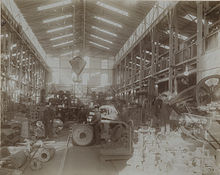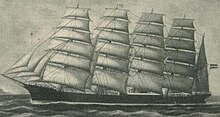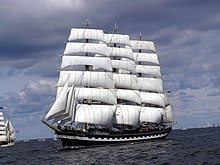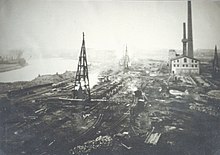Joh. C. Tecklenborg
The Joh. C. Tecklenborg shipyard in Geestemünde and Wesermünde existed from 1841 to 1928 and was known as a specialist in the construction of high-quality sailing ships . The saying common at the time: “ Captain, don't worry, the ship is built in Tecklenborg ” speaks for itself. In 1926, the shipyard became part of the Bremer Deutsche Schiff- und Maschinenbau Aktiengesellschaft (Deschimag), which shut down operations two years later.
history
Founding years
On September 30, 1841, Jan Simon Abegg signed a contract for the construction of another shipyard in Bremerhaven with the deputation for the administration of public properties in Bremen . The construction site was next to the site of the Rickmers shipyard , which had been built there a few years earlier, and had to be enforced against the resistance of the long-established residents (RC Rickmers and others). The contract was valid for 13 years. The rent Abegg had to pay was twice as high as that Rickmers had to pay. A few seagoing ships were built (two full ships and three barges), but the initial difficulties proved insurmountable for Abegg. In 1843 the business was started by Franz Tecklenborg (1807–1886) - the oldest of ten children of the Bremen sailmaker, ship owner and merchant Franz Tecklenborg senior. (1780-1821) - adopted. From this Abegg had received the financial means to found his company. Franz Tecklenborg was able to win his brother Johann Carl as a ship's room for the company. In January 1845, Johann Carl Tecklenborg took over the Abegg lease and continued the business under his own name: Joh. C. Tecklenborg .
Expansion of the first shipyard
Over time, Tecklenborg built bigger and bigger ships and decided to build a dry dock . On the Bremen side of the Geeste , however, there was no more space. Therefore, in 1852 a suitable site in Geestemünde - that is, in Hanover's “foreign country” - was leased. The following year, the company was opened on the other (left) side of the Geeste. The König-Georg-Dock was built under the direction of the Hanoverian hydraulic engineering inspector Dincklage. At the time, the dry dock was a great technical achievement. In 1855 it was put into operation with the docking of the Bremen brig Mathilde . Today the Tecklenborg house on Claussenstrasse is located at this place.
Around 100 ship carpenters worked at Tecklenborg in the 1860s. The company was busy building and repairing ships. In 1863 the rented shipbuilding site in Bremerhaven was bought. The contract was signed on September 30, 1863 by Tecklenborg and the deputation for the ports and port authorities in Bremen. From 1867 fishing trawlers were also built. In 1869 the schooner Germania was built in the König-Georg-Dock in the record time of 28 days for the Second German North Pole Expedition .
In 1872 Eduard Tecklenborg - the youngest son from the second marriage of the shipyard founder Franz Tecklenborg - received procuration together with Georg Wilhelm Claussen . Johann Carl Tecklenborg died on October 14, 1873. His successor as technical director was Georg Wilhelm Claussen. He had completed vocational training at the Tecklenborg shipyard and then worked for a Scottish shipbuilding company as a draftsman and designer for a few years. In 1869 he returned to the Tecklenborg shipyard and became its co-owner in 1876. He realized that the company could no longer grow on the Bremerhaven site that had been used up until then.
In 1879 the last wooden sailing ship was built with the barque Figaro . Most of the ships built in the following years were fish steamers with riveted steel hulls.
Move to Geestemünde
In 1881 the company was relocated to Geestemünde. After buying several plots of land on the Wählacker, a peninsula surrounded by the Geeste , a new, larger shipyard was built in this Geestebogen. In 1882, the Tecklenborg shipyard was one of the first Bremerhaven shipyards to switch from the tried and tested wooden shipbuilding to iron shipbuilding . In the spring of 1882, the new shipbuilding facility on the Wählacker with the keel-laying of the seagull was put into operation for North German Lloyd . As early as the summer of 1882, three slipways were ready for use. In this year the first workshops, warehouses and the administration building were built. In the same year the first iron ship, the Hansadampfer Eberstein , was built. In 1888, the first in Germany was steel -made full-rigged ship , the Naiad , for the shipping company Gildemeister & Ries (1897 to Visurgis AG was converted) built. The fourth slipway was built in 1890. In 1894 the first tanker steamer built at a German shipyard , the August Korff , was launched .
Last bloom in sailing shipbuilding
Contrary to the general trend, there was a final high point in the construction of steel four- and five-masted barques in Germany and France (three in all, two of which were by Rickmers). Tecklenborg's technical director, Claussen, was of the opinion that despite the higher speed of steamships, sailing ships could keep up on certain voyages if they were appropriately equipped. For the saltpetre transport from the west coast of South America to Europe , windjammers should be able to make relatively fast and cheap trips using the trade winds . The first five-masters built at a German shipyard, the Potosi , provided proof of this thesis . The Potosi was a highlight of the steel sailing ship building near Tecklenborg. It was launched in 1895.
In 1897 the Joh. C. Tecklenborg shipyard was converted into a public limited company. The share capital was initially 1,400,000 marks and was increased to 18,900,000 marks in the years of German inflation until 1922. Eduard Tecklenborg and Georg Wilhelm Claussen formed the board. In 1908 Eduard Tecklenborg moved to the supervisory board. Members of the supervisory board included Dr. jur. Clemens Carl Buff and August Dubbers . In addition to Georg Wilhelm Claussen, Fritz Tecklenborg and Dr. Ing. Hans Wach Management Board positions.
Until the beginning of the First World War, the shipyard was constantly expanded. In 1897 the shipyard at the southern end of the fishing port was able to put a slipway for fish steamers into operation. In 1899 the factory premises were connected to the railway. On May 7, 1902, the five-mast full ship Prussia was launched. At the time it was the largest sailing ship in the world (until July 1902, the Thomas W. Lawson was launched ). By 1901, the size of the ships built could be increased. The restriction resulted from the location of the shipyard on the narrow and curved Geeste and the bridge over the river. So that larger ships could be built near Tecklenborg , the Geeste was regulated and in 1904 a new swing bridge was built over the Geeste.
strike
In June 1904 around 150 boilermakers went on strike because of wage demands and unregulated piecework conditions. In response, the entire workforce at the Tecklenborg and Seebeck shipyards was dismissed. After seven weeks the dispute was ended after minor concessions on the part of the shipyard management. In December, the place before the Geestemünder Criminal Court against strikers Big breach of the peace process instead.
Beginning of the construction of large ships
After the completion of the bridge, it was possible to move on to building large ships and thus to transition from a craft business to an industrial shipyard. In 1904 and 1905, the striking steel frame was built above Helgen 6 and 7, giving the shipyard a distinctive profile. Between 1904 and 1908, a new boiler shop and a 150 t bank crane moved by electric motors were built. The administration building ("Grauer Esel") was built in 1906/07 in Art Nouveau style.
The most important client at the time was North German Lloyd. The Reichspostdampfer Prinz Friedrich Wilhelm (17,082 GRT) was built for this shipping company in 1908 . In 1912 the first ship with a diesel engine, the Rolandseck , was delivered. In 1915 the largest ship built on the Lower Weser was completed, the 19,802 GRT passenger ship Johann Heinrich Burchard .
War years
When the First World War broke out , shipbuilding was booming. Tecklenborg had around 3,500 employees and thirteen large ships were under construction. However, these were no longer required by the clients. Large parts of the permanent workforce were called up for military service - the rest had to work off the remaining orders. However, there were orders for minesweepers and submarines from the Imperial Navy . Due to the poor quality of the minesweepers delivered, the Imperial Navy withdrew the orders.
After the end of the war, locomotives and wagons were also repaired at the shipyard. Claussen was made an honorary citizen of Geestemünde and Dockstrasse was renamed Claussenstrasse .
Crisis and end of the shipyard
In 1924/25 the order situation was poor. At the instigation of the Bremen banker Johann Friedrich Schröder , the Vulcan-Werke in Hamburg and Joh. C. Tecklenborg AG in Wesermünde were incorporated into the stock corporation "Weser" in Bremen. Thus, on December 28, 1926, the Deutsche Schiff- und Maschinenbau Aktiengesellschaft (Deschimag) was established as the first major corporation in the German shipbuilding industry , with its administrative headquarters in Bremen. Georg Wilhelm Claussen joined the company's board of directors. On November 29, 1926, Joh. C. Tecklenborg AG was deleted from the commercial register. The Tecklenborg shipyard had become part of Deschimag.
Soon afterwards it became clear that the Actien-Gesellschaft “Weser” and the Tecklenborg shipyard were building ships of comparable size and had a similar production program. There were also two shipyards at the same location in today's Bremerhaven: Seebeck in Wesermünde and Tecklenborg in Geestemünde. The Deschimag board members decided to close the Tecklenborg shipyard.
On June 11, 1926, the last four-masted barque, a sailing freighter called Padua , was launched. On June 14, 1927, the last tall ship built at the Tecklenborg shipyard was launched, the training ship Deutschland .
In 1928 Norddeutsche Lloyd withdrew two orders, which prompted the Bremerhaven Chamber of Commerce and Industry to state that "the unprofitable Tecklenborg shipyard for 1927/28 was deliberately brought about by artificial measures taken by Deschimag".
After the end
On August 1, 1928, the closure of the Tecklenborg shipyard and the demolition of the facilities were approved by the district government. With some of the systems - e.g. B. the König-Georg-Dock - the Seebeck shipyard was modernized and expanded. Around 400 employees found work at the stock corporation "Weser". In 1934 the Reichsmarine took over the former Tecklenborg site. On October 5, 1935, construction work began on the naval school. Before the construction work could begin, the remaining shipyards were dismantled by recruited unemployed people. In 1968 the König-Georg-Dock was filled in and in 1971 the administration building was demolished.
December 16, 1998: The Tecklenborg shipyard is back on the Geeste - as a 3 m² model in the Bremerhaven Historical Museum . The model maker of the Otto Freudenthal Museum has reconstructed the famous company in great detail over several years using photos and old plans.
Ships
The following list contains some of the ships that were built at Tecklenborg shipyard:
- Admiral Brommy ( Bark , built 1851), fate unknown
- SV Admiral Tegetthoff ( barque built 1871), until 1891 Wätjen HD & Co., Bremen, owned by Schlubach, Thiemer & Co from 1899–1907
- Admiral Tegetthoff ( Schonerbark , built 1872); Austro-Hungarian North Pole Expedition
- Andromeda ( clipper , built 1885); first sailing tanker in the world
- August Korff (tanker, built 1894); first tanker steamer built at a German shipyard
- Bülow ( Reichspostdampfer of the general class of the NDL , built 1906)
- Creole (Bark, built 1845)
- Eberstein (screw steamer, built 1883), DDG "Hansa" Mediterranean service - the shipyard's first iron ship
- Eduard (Bark, built 1847)
- Figaro (Bark, built 1879); last wooden sailing ship
- Germania (schooner, built 1869); second German north polar expedition
- Helvetia (Bark, built 1858) emigrant ship
- Hera (four-masted barque, built 1896)
- Johann Heinrich Burchard (passenger steamer of 20,000 GRT - the largestship builtby Tecklenborg , built in 1914, Reliance from 1920)
- Johannisberger (cargo steamer, built 1889, Asia line of the DDG "Hansa")
- Möwe (Lloyddampfer, built 1882)
- Najade (full ship, built 1888) first full ship made of steel in Germany
- Neckar combi ship for the NDL, 9835 BRT, 1901 the largest new building to date
- SMS Otter (1909) River gunboat of the Imperial Navy for the Yangtze in China
- Pangani (four-masted steel barque, built in 1903,sunk with 30 of 34 menafter a collision in the English Channel with the French steamer Phryné on January 18, 1913)
- Parchim (full ship, built 1889)
- Pera (full ship, built 1890)
- Pisagua (four-masted steel barque, built 1892)
- Pungo (refrigerated ship of the Pioner class , built 1914) - later as SMS Möve
- Placilla (four-masted steel barque, built 1892)
- Potosi (steel five-masted barque, built 1895); The nowcalled Flora , driverless, burnt-out wreck wassunkby the Argentine cruiser Patria off Comodoro Rivadavia in 1925after a compressed coal fire with a severe explosion, with the loss of the entire rig (except for the foremast ).
- Prussia (five-masted full ship, built 1902); stranded in the English Channel on 6 November 1910after colliding with the English steamer Brighton .
- Prinz Friedrich Wilhelm (NDL passenger steamer, built 1907)
- Richard Wagner (four-masted barque, built 1886), hull made of English iron
- Rolandseck (cargo ship, built 1912), one of the first ships with a diesel engine
- Roon (double screw steamer of the general class, built 1903), Reichspostdampfer of the NDL
- Scharnhorst (built 1904), Reichspostdampfer of the NDL of the Feldherren class
- Welcome (Salon paddle steamer for NDL, built 1884)
Received ships
- Grand Duke Friedrich August (barque, training ship, built 1914); today: Statsraad Lehmkuhl
- Padua (four-masted barque, built 1926); today: Kruzenstern
- Training ship Germany (full ship, built 1927); today a museum ship in Bremen-Vegesack
- Training ship Grand Duchess Elisabeth ( full ship , built 1901); today Duchesse Anne in Dunkirk
- Seefalke (sea rescue tug, built 1924); today a museum ship in Bremerhaven
Shipyard manager
- Franz Tecklenborg (1807-1886)
- Johann Carl Tecklenborg (1820–1873)
- Georg Wilhelm Claussen (1845-1919)
- Eduard Tecklenborg (1849-1926)
- Georg Claussen (1877–1944)
- Fritz Tecklenborg (1888–1964)
- Hans Wach (1879–1961)
literature
- Eike Lehmann: 100 Years of the Shipbuilding Society . Springer-Verlag, Berlin 1999, ISBN 3-540-64150-5 , pp. 491 .
- Peter-Michael Pawlik: From the Weser into the world . tape 3 . HM Hauschild Verlag, Bremen 2008, ISBN 978-3-89757-332-1 , p. 316-325 .
- Hans-Walter Keweloh (introduction), H. Cordes (report): “From old sailing ship times in Bremen.” The report of an eyewitness from 1950 . In: Men from Morgenstern , Heimatbund an Elbe and Weser estuary e. V. (Ed.): Niederdeutsches Heimatblatt . No. 841 . Nordsee-Zeitung GmbH, Bremerhaven January 2020, p. 1–2 ( digital copy [PDF; 5.0 MB ; accessed on April 17, 2020]).
Web links
- Peter Müller: On the history of the Tecklenborg shipyard 1871-1924 , accessed on August 5, 2013.
- The Tecklenborg shipyard on the website of the Historisches Museum Bremerhaven







